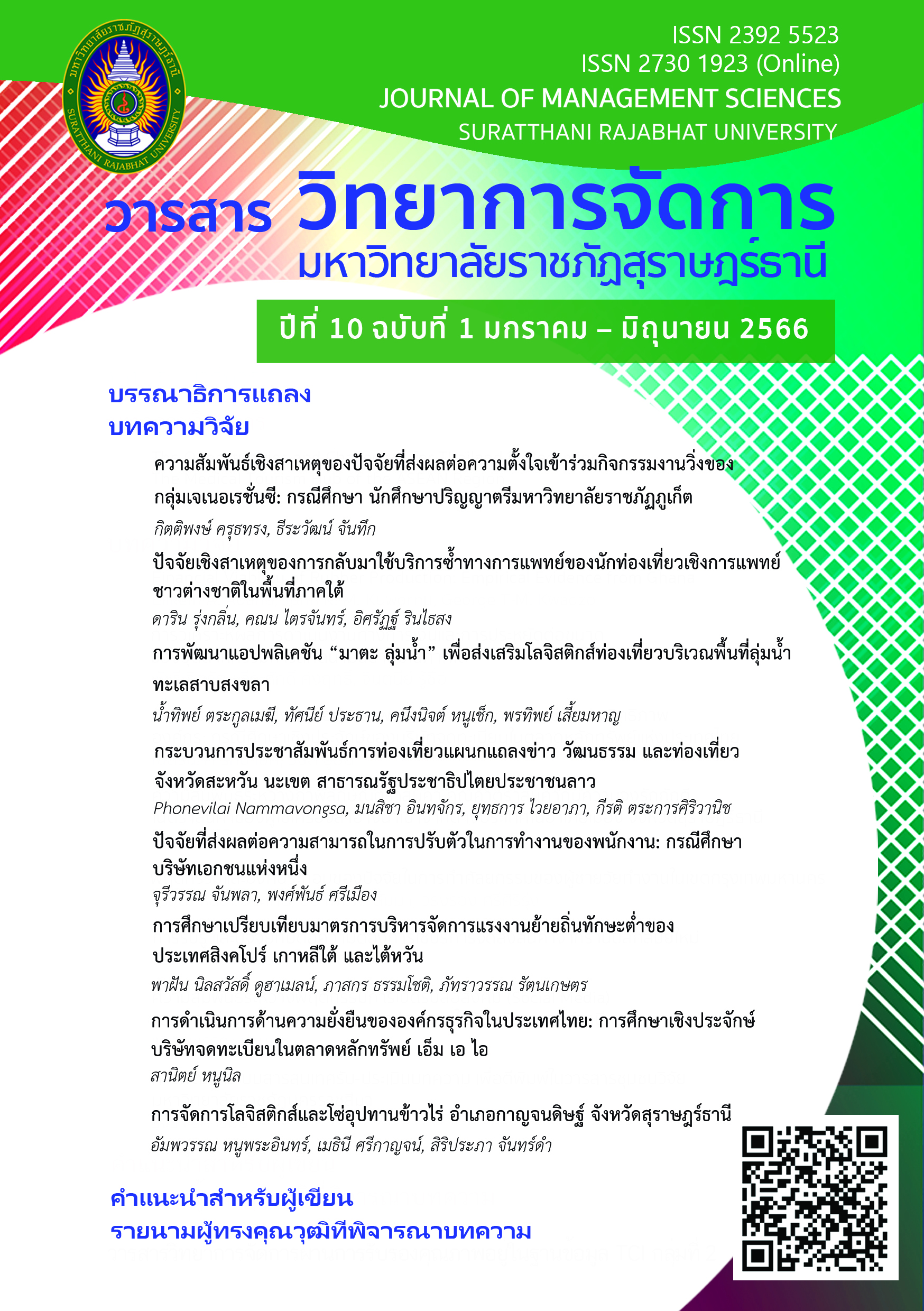การศึกษาเปรียบเทียบมาตรการบริหารจัดการแรงงานย้ายถิ่นทักษะต่ำของประเทศสิงคโปร์ เกาหลีใต้ และไต้หวัน
Main Article Content
บทคัดย่อ
การเคลื่อนย้ายแรงงานระหว่างประเทศมีแนวโน้มเพิ่มขึ้น แต่ละประเทศจึงต้องมีมาตรการในการจัดการและควบคุมการไหลเข้าของแรงงาน งานวิจัยนี้มีวัตถุประสงค์ คือ 1) ศึกษามาตรการการรับเข้าแรงงานย้ายถิ่นทักษะต่ำของประเทศสิงคโปร์ เกาหลีใต้ และไต้หวัน 2) เปรียบเทียบมาตรการการรับเข้าแรงงานย้ายถิ่นทักษะต่ำของประเทศสิงคโปร์ เกาหลีใต้ และไต้หวัน โดยใช้วิธีการเก็บข้อมูลจากเอกสารและการสัมภาษณ์เชิงลึก กลุ่มตัวอย่างคัดเลือกหัวหน้าหน่วยงานที่เกี่ยวข้องกับกระบวนการเคลื่อนย้ายแรงงานทั้งในไทยและต่างประเทศ และแรงงานไทยที่ทำงานอยู่ในประเทศกรณีศึกษา ผลการวิจัยพบว่า มาตรการบริหารจัดการการนำเข้าแรงงานย้ายถิ่นทักษะต่ำของประเทศสิงคโปร์ เกาหลีใต้ และไต้หวัน ใช้แนวทาง “Employer-Driven” คือ นำเข้าแรงงานตามความต้องการของนายจ้างเป็นสำคัญอย่างไรก็ตาม เพื่อเป็นการควบคุมปริมาณและคุณภาพในการรับแรงงานย้ายถิ่นที่มีประสิทธิภาพและไม่ก่อผลกระทบทางเศรษฐกิจ การเมือง และสังคมภายในประเทศ ทั้ง 3 ประเทศจึงกำหนดเงื่อนไขในการรับเข้าแรงงานย้ายถิ่นทักษะต่ำในด้านต่างๆ ได้แก่ ช่องทางการรับเข้า คุณสมบัติของแรงงาน เช่น อายุ ทักษะภาษา ทักษะแรงงาน เพดานการจ้างแรงงานต่างชาติ ภาษีการจ้างแรงงานต่างชาติ และคุณสมบัติของนายจ้าง ทั้งนี้เงื่อนไขดังกล่าวขึ้นอยู่กับนโยบายและสภาพแวดล้อมทางเศรษฐกิจสังคมของแต่ละประเทศ
Article Details

อนุญาตภายใต้เงื่อนไข Creative Commons Attribution-NonCommercial-NoDerivatives 4.0 International License.
เอกสารอ้างอิง
Ayuwat, D., Aimimtham S., & Theerawisit, A. (2010). Livehoods of Thai Workers in Taiwan: a Study of Destination. Journal of Humanity and Social Science Khonken, 27(1), 1-28.
Bunmak S., & Chaophanitcharoen, P. (2020). International Migration Policy of Foreign Workers: A Case Study of Immigration and Employment in Taiwan. KKU International Journal of Humanities and Social Sciences, 10 (2), 122-154.
Department of Employment. (2021). Oversea Employment Aboard. http://www.doe.go.th/prd/assets/upload/files/overseas_th/0040b52562415899899af9fbd95474e9.pdf.
Disyatat, P. (2015). Illegal Thai Workers in Republic of Korea. Ministry of Foreign Affairs. Individual Study, International Institute of Devawongsewarophakorn, Ministry of Foreign Affairs.
Equal times. (2020). Will Taiwan reform its system of labour brokerage to better protect migrant workers?. https://www.equaltimes.org/will-taiwan-reform-its-system-of
HRD Thailand (personal communication, January 30, 2022)
G. Sripaurya (personal communication, December 1, 2021)
ILO and UN Women. (2020). Public attitudes towards migrant workers in Singapore December 2020. https://www.ilo.org/wcmsp5/groups/public/---asia/---ro-bangkok/documents/briefingnote/wcms_766633.pdf
Kulkolkarn, K. (2014). Management of Foreign Workers in Thailand and Aboard. The Thailand Research Fund.
Kulkolkarn, K. (2016). Cost-Benefit for Economic of Thai Migrant Worker: A Case Study of Taiwan. Bangkok Bloc: Bangkok.
Kulkolkarn, K. (2019) Illegal Thai Workers in the Republic of Korea : Causes of Problems and Solutions. Journal of Intelligence, 14 (1), 105-121.
Ministry of Manpower, Singapore (n.d.) Work Permit for Migrant Worker. https://www.mom.gov.sg/.
O. Thongboumakrod (personal communication, September 22, 2021)
Office of Labor Affairs, Royal Thai Embassy, Kaohsiung (2021). Guidebook for Thai workers in Taiwan. https://taipei.mol.go.th/wpcontent/uploads/sites/9/2021/01A1-2564.pdf
Office of Labour Affairs, Royal Thai Embassy, Singapore (2016). Singapore Employment Policies and Thai Workers. https://singapore.mol.go.th/news.
Office of Labour Affairs, Royal Thai Embassy, Singapore. (2022). Demand for Thai Labour in Singapore. https://singapore.mol.go.th/situation/trends-and-opportunities-of-thai-workers.
Office of Labour Affairs, Royal Thai Embassy, Seoul. (2018). Labour Market in Republic of Korea. https://korea.mol.go.th/situation/thai-labor-market.
Pinitpuvadol, K., Taweejamsap, S., & Tassanaipitakkul, N. (2016). Migrant Workers. International Institute for Trade and Development.
Rungruekrit, C., Suwanprapa, V., & Sanamchuan S. (2011). A Study on Thai Labour Protection in Taiwan. Thai Human Resource Research Journal, 6 (2), 13-26.
Recruitment Agencies (personal communication, September 1-5, 2021)
S.Laodamrongchai (personal communications, August 22, 2021)
Shimanuki, S. (2021). Financial Inclusion of Migrant Workers in Singapore. Scholarly Commons, 1-20. https://repository.upenn.edu/sire/90.
Srisen, N. (2019) Thai migrants’ Mobility and Illegality in South Korea. Journal of Social Science Chiangmai University, 31(1), 144-170.
Thailand Trade and Economics Office. (2022). Policies and Quotas for Foreign Workers Employment. https://taipei.mol.go.th/situation/trends-and-opportunities-of-thai-workers.
Teng, Y., M. (2014) Singapore’s System for Managing Foreign Manpower Managing International Migration for Development in East Asia. The World Bank Group, 220-240.
T. Singsrida (personal communication, June 18, 2021)
Thai Migrant Workers in Taiwan (personal communication, October 20, 2021)
Thai Migrant Workers (personal communication, October 1-5, 2021)
Thai Migrant Workers in Taiwan, Singapore, South Korea and Labor Recruitment Agencies (personal communication, October 1-15, 2021)
Wongboonsin. (2009) Migration theories and the patterns of the migration situation in Asia. Bangkok: College of Population Studies, Chulalongkorn University.
Workforce Development Agency, Ministry of Labor. (2022). Work Qualifications and Rules for Foreign Workers. https://www.wda.gov.tw/en/NewsFAQ.aspx?n=26470E539B6FA395&sms=0FCDB188C74F69A0
World Bank. (2017). Migrating to Opportunities: Overcoming Barriers to Labor Mobility in Southeast Asia. https://openknowledge.worldbank.org/bitstream/handle/10986/28342/9781464811067.pdf


